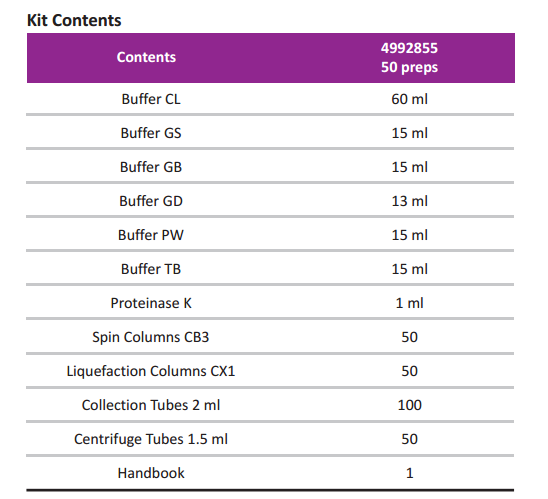DP335 TIANamp Blood Clot DNA Kit
TIANamp Blood Clot DNA Kit
For isolation of genomic DNA from 0.1-1 ml blood clot
TIANamp Blood Clot DNA Kit (0.1-1 ml)
Cat. no. 4992855
(Spin Column)

Required Reagents
RNase A (100 mg/ml) (TIANGEN)
Storage
TIANamp Blood Clot DNA Kit can be stored dry at room temperature (15-
30°C) for up to 15 months without showing any reduction on performance
and quality. If any precipitate forms in the buffers, it should be dissolved by
warming the buffers at 37°C before use.
Introduction
TIANamp Blood Clot DNA Kit uses silica membrane technology and unique
buffer system for blood clot gDNA extraction. The spin column is made of
new type silica membrane can be easily bounded by DNA specifically while
removing protein and other organic compounds in the cell to as much as
possible. The gDNA which extracted by this kit is integrate, pure and stable.
The extracted gDNA with high quality can be used for restriction enzyme
digestion, PCR analysis, library construction, Southern blot, etc.
Product Features
Simple and fast:gDNA can be easily extracted within 1 h.
High purity: extracted gDNA can be directly used in biological experiments
like PCR, enzyme digestion, molecular hybridization, etc
Important Notes Please read the notes before use.
- Ethanol (96-100%) should be added to Buffer GD and Buffer PW as
indicated on the bot before use. - Samples should not be frozen and thawed repeatedly, or else the
integrity and yield of DNA would be affected negatively. - If precipitates have been formed in Buffer GB, dissolve them by
incubating at 37°C. - All centrifugation steps should be carried out in a conventional table-top
microcentrifuge at room temperature (15-30°C). - If the blood clot sample is more than 1 ml, please purchase TIANGEN
TIANamp Blood DNA Midi Kit (4992854) and Liquefaction Columns CX2/
CX3.
Protocol
- Preparation of blood samples (This kit is designed for 0.1-1 ml blood clot
sample)
a. Load blood clot samples to Liquefaction Columns CX1, centrifuge
at 12,000 rpm (~11,500 × g) for 1 min, collect the flow-through for
next step (Blood clot can be prepared separately if the sample volume
exceeds the capacity).
b. Mix the flow-through with 1-2.5 times volume of Buffer CL by
inverting. Centrifuge at 10,000 rpm (~11,500 × g) for 1 min, discard the
supernatant and keep the cell debris (Step b can be repeated once to
ensure a complete lysis procedure). Add 200 μl Buffer GS to the cell
debris, mix thoroughly by vortex.
Note: If RNA-free genomic DNA is required, add 4 μl RNase A (100
mg/ml, should be prepared by user). Mix by vortex for 15 sec, and
incubate for 5 min at room temperature (15-30°C). - Add 20 μl Proteinase K, mix thoroughly by vortex.
- Add 300 μl Buffer GB to the sample, mix thoroughly by inverting, and
incubate at 56°C for 10 min to yield a clear solution, during which
samples need to be mixed by inverting several times (If the mixture does
not clear, please extend the cracking time until the solution is clear). - Add 300 μl ethanol (96-100%), and mix thoroughly by inverting. A white
precipitate should be formed with the addition of ethanol. - Pipet the mixture from step 4 into the Spin Column CB3 (in a 2 ml
collection tube) and centrifuge at 12,000 rpm (~13,400 × g) for 30 sec.
Discard flow-through and replace the spin column into the collection
tube. - Add 500 μl Buffer GD (ensure ethanol has been added)to Spin Column
CB3, and centrifuge at 12,000 rpm (~13,400 × g) for 30 sec, then discard
the flow-through and replace the spin column into the collection tube. - Add 600 μl Buffer PW (ensure ethanol has been added)to Spin Column
CB3, and centrifuge at 12,000 rpm (~13,400 × g) for 30 sec. Discard the
flow-through and place the spin column into the collection tube. - Repeat Step 7.
- Set the Spin Column CB3 back to the Collection Tube and centrifuge at
12,000 rpm (~13,400 × g) for 2 min to dry the membrane completely.
Discard the flow-through, and allow the column to air dry with the cap
open for several minutes to dry the membrane.
Note: The purpose of this step is to completely remove residual
ethanol which may interfere with down-stream reactions (enzyme
digestion and PCR). - Place the Spin Column CB3 in a new clean 1.5 ml microcentrifuge tube,
and pipet 50-200 μl Buffer TB or distilled water directly to the center of
the membrane. Incubate at room temperature (15-30°C) for 2-5 min,
and then centrifuge for 2 min at 12,000 rpm (~13,400 × g).
Note: The volume of elution buffer should not be less than 50 μl, or it
may affect the recovery efficiency. In order to get a high yield, flowthrough could be pipetted back to the membrane and incubated at
room temperature for 2 min, then centrifuge again at 12,000 rpm
(~13,400× g) for 2 min. The pH value of elution buffer has a great
impact on eluting, we suggest that the pH value should be within the
range of 7.0-8.5 if distilled water is used as elution buffer. Low pH
value (pH<7) would significantly reduce the efficiency of elution. DNA
product should be stored at -20°C to avoid the degradation.
DP335 TIANamp Blood Clot DNA Kit
All trademarks or registered trademarks appearing on this website are the property of their respective owners.
This product is for scientific research use only. Do not use in medicine, clinical treatment, food or cosmetics.
Need more info ? Contact us anytime. We’re here: Go2biotech
E-mail: maggie@go2biotech.com / morgan@go2biotech.com
Telephone:+86 755 8399 5017


